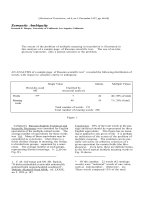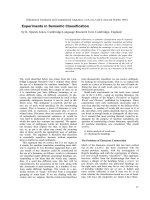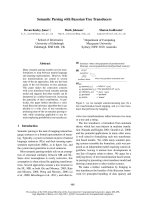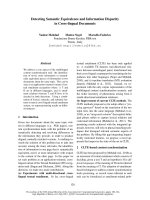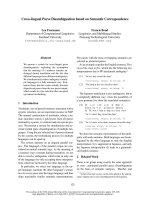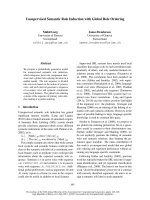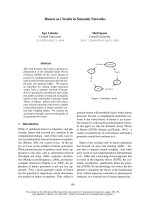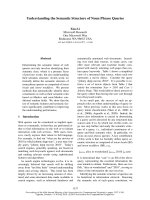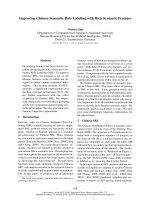Tài liệu Báo cáo khoa học: "Ontologizing Semantic Relations" pdf
Bạn đang xem bản rút gọn của tài liệu. Xem và tải ngay bản đầy đủ của tài liệu tại đây (89.05 KB, 8 trang )
Proceedings of the 21st International Conference on Computational Linguistics and 44th Annual Meeting of the ACL, pages 793–800,
Sydney, July 2006.
c
2006 Association for Computational Linguistics
Ontologizing Semantic Relations
Marco Pennacchiotti
ART Group - DISP
University of Rome “Tor Vergata”
Viale del Politecnico 1
Rome, Italy
Patrick Pantel
Information Sciences Institute
University of Southern California
4676 Admiralty Way
Marina del Rey, CA90292
Abstract
Many algorithms have been developed
to harvest lexical semantic resources,
however few have linked the mined
knowledge into formal knowledge re-
positories. In this paper, we propose two
algorithms for automatically ontologiz-
ing (attaching) semantic relations into
WordNet. We present an empirical
evaluation on the task of attaching part-
of and causation relations, showing an
improvement on F-score over a baseline
model.
1 Introduction
NLP researchers have developed many algo-
rithms for mining knowledge from text and the
Web, including facts (Etzioni et al. 2005), se-
mantic lexicons (Riloff and Shepherd 1997),
concept lists (Lin and Pantel 2002), and word
similarity lists (Hindle 1990). Many recent ef-
forts have also focused on extracting binary se-
mantic relations between entities, such as
entailments (Szpektor et al. 2004), is-a (Ravi-
chandran and Hovy 2002), part-of (Girju et al.
2003), and other relations.
The output of most of these systems is flat lists
of lexical semantic knowledge such as “Italy is-a
country” and “orange similar-to blue”. However,
using this knowledge beyond simple keyword
matching, for example in inferences, requires it
to be linked into formal semantic repositories
such as ontologies or term banks like WordNet
(Fellbaum 1998).
Pantel (2005) defined the task of ontologizing
a lexical semantic resource as linking its terms to
the concepts in a WordNet-like hierarchy. For
example, “orange similar-to blue” ontologizes in
WordNet to “orange#2 similar-to blue#1” and
“orange#2 similar-to blue#2”. In his framework,
Pantel proposed a method of inducing ontologi-
cal co-occurrence vectors
1
which are subse-
quently used to ontologize unknown terms into
WordNet with 74% accuracy.
In this paper, we take the next step and explore
two algorithms for ontologizing binary semantic
relations into WordNet and we present empirical
results on the task of attaching part-of and causa-
tion relations. Formally, given an instance
(x, r, y) of a binary relation r between terms x
and y, the ontologizing task is to identify the
WordNet senses of x and y where r holds. For
example, the instance (proton,
PART-OF, element)
ontologizes into WordNet as (proton#1,
PART-OF,
element#2).
The first algorithm that we explore, called the
anchoring approach, was suggested as a promis-
ing avenue of future work in (Pantel 2005). This
bottom up algorithm is based on the intuition that
x can be disambiguated by retrieving the set of
terms that occur in the same relation r with y and
then finding the senses of x that are most similar
to this set. The assumption is that terms occur-
ring in the same relation will tend to have similar
meaning. In this paper, we propose a measure of
similarity to capture this intuition.
In contrast to anchoring, our second algorithm,
called the clustering approach, takes a top-down
view. Given a relation r, suppose that we are
given every conceptual instance of r, i.e., in-
stances of r in the upper ontology like (parti-
cles#1,
PART-OF, substances#1). An instance
(x, r, y) can then be ontologized easily by finding
the senses of x and y that are subsumed by ances-
tors linked by a conceptual instance of r. For ex-
ample, the instance (proton,
PART-OF, element)
ontologizes to (proton#1,
PART-OF, element#2)
since proton#1 is subsumed by particles and
element#2 is subsumed by substances. The prob-
lem then is to automatically infer the set of con-
1
The ontological co-occurrence vector of a concept con-
sists of all lexical co-occurrences with the concept in a
corpus.
793
ceptual instances. In this paper, we develop a
clustering algorithm for generalizing a set of re-
lation instances to conceptual instances by look-
ing up the WordNet hypernymy hierarchy for
common ancestors, as specific as possible, that
subsume as many instances as possible. An in-
stance is then attached to its senses that are sub-
sumed by the highest scoring conceptual
instances.
2 Relevant Work
Several researchers have worked on ontologizing
semantic resources. Most recently, Pantel (2005)
developed a method to propagate lexical co-
occurrence vectors to WordNet synsets, forming
ontological co-occurrence vectors. Adopting an
extension of the distributional hypothesis (Harris
1985), the co-occurrence vectors are used to
compute the similarity between synset/synset and
between lexical term/synset. An unknown term is
then attached to the WordNet synset whose co-
occurrence vector is most similar to the term’s
co-occurrence vector. Though the author sug-
gests a method for attaching more complex lexi-
cal structures like binary semantic relations, the
paper focused only on attaching terms.
Basili (2000) proposed an unsupervised
method to infer semantic classes (WordNet syn-
sets) for terms in domain-specific verb relations.
These relations, such as (x,
EXPAND, y) are first
automatically learnt from a corpus. The semantic
classes of x and y are then inferred using concep-
tual density (Agirre and Rigau 1996), a Word-
Net-based measure applied to all instantiation of
x and y in the corpus. Semantic classes represent
possible common generalizations of the verb ar-
guments. At the end of the process, a set of syn-
tactic-semantic patterns are available for each
verb, such as:
(social_group#1, expand, act#2)
(instrumentality#2, expand, act#2)
The method is successful on specific relations
with few instances (such as domain verb rela-
tions) while its value on generic and frequent
relations, such as part-of, was untested.
Girju et al. (2003) presented a highly super-
vised machine learning algorithm to infer seman-
tic constraints on part-of relations, such as
(object#1,
PART-OF, social_event#1). These con-
straints are then used as selectional restrictions in
harvesting part-of instances from ambiguous
lexical patterns, like “X of Y”. The approach
shows high performance in terms of precision
and recall, but, as the authors acknowledge, it
requires large human effort during the training
phase.
Others have also made significant additions to
WordNet. For example, in eXtended WordNet
(Harabagiu et al. 1999), the glosses in WordNet
are enriched by disambiguating the nouns, verbs,
adverbs, and adjectives with synsets. Another
work has enriched WordNet synsets with topi-
cally related words extracted from the Web
(Agirre et al. 2001). Finally, the general task of
word sense disambiguation (Gale et al. 1991) is
relevant since there the task is to ontologize each
term in a passage into a WordNet-like sense in-
ventory. If we had a large collection of sense-
tagged text, then our mining algorithms could
directly discover WordNet attachment points at
harvest time. However, since there is little high
precision sense-tagged corpora, methods are re-
quired to ontologize semantic resources without
fully disambiguating text.
3 Ontologizing Semantic Relations
Given an instance (x, r, y) of a binary relation r
between terms x and y, the ontologizing task is to
identify the senses of x and y where r holds. In
this paper, we focus on WordNet 2.0 senses,
though any similar term bank would apply.
Let S
x
and S
y
be the sets of all WordNet senses
of x and y. A sense pair, s
xy
, is defined as any
pair of senses of x and y: s
xy
={s
x
, s
y
} where s
x
∈S
x
and s
y
∈S
y
. The set of all sense pairs S
xy
consists
of all permutations between senses in S
x
and S
y
.
In order to attach a relation instance (x, r, y)
into WordNet, one must:
• Disambiguate x and y, that is, find the subsets
S'
x
⊆S
x
and S'
y
⊆S
y
for which the relation r holds;
and
• Instantiate the relation in WordNet, using the
synsets corresponding to all correct permuta-
tions between the senses in S'
x
and S'
y
. We de-
note this set of attachment points as S'
xy
.
If S
x
or S
y
is empty, no attachments are produced.
For example, the instance (study,
PART-OF, re-
port) is ontologized into WordNet through the
senses S'
x
={survey#1, study#2} and
S’
y
={report#1}. The final attachment points S'
xy
are:
(survey#1, PART-OF, report#1)
(study#1,
PART-OF, report#1)
Unlike common algorithms for word sense
disambiguation, here it is important to take into
consideration the semantic dependency between
the two terms x and y. For example, an entity that
is part-of a study has to be some kind of informa-
794
tion. This knowledge about mutual selectional
preference (the preferred semantic class that fills
a certain relation role, as x or y) can be exploited
to ontologize the instance.
In the following sections, we propose two al-
gorithms for ontologizing binary semantic rela-
tions.
3.1 Method 1: Anchor Approach
Given an instance (x, r, y), this approach fixes the
term y, called the anchor, and then disambiguates
x by looking at all other terms that occur in the
relation r with y. Based on the principle of distri-
butional similarity (Harris 1985), the algorithm
assumes that the words that occur in the same
relation r with y will be more similar to the cor-
rect sense(s) of x than the incorrect ones. After
disambiguating x, the process is then inverted
with x as the anchor to disambiguate y.
In the first step, y is fixed and the algorithm
retrieves the set of all other terms X' that occur in
an instance (x', r, y), x' ∈ X'
2
. For example, given
the instance (reflections,
PART-OF, book), and a
resource containing the following relations:
(false allegations, PART-OF, book)
(stories,
PART-OF, book)
(expert analysis,
PART-OF, book)
(conclusions,
PART-OF, book)
the resulting set X' would be: {allegations, sto-
ries, analysis, conclusions}.
All possible permutations, S
xx'
, between the
senses of x and the senses of each term in X',
called S
x'
, are computed. For each sense pair
{s
x
, s
x'
} ∈ S
xx'
, a similarity score r(s
x
, s
x'
) is calcu-
lated using WordNet:
)(
1),(
1
),(
'
'
' x
xx
xx
sf
ssd
ssr ×
+
=
where the distance d(s
x
, s
x'
) is the length of the
shortest path connecting the two synsets in the
hypernymy hierarchy of WordNet, and f(s
x'
) is
the number of times sense s
x'
occurs in any of the
instances of X'. Note that if no connection be-
tween two synsets exists, then r(s
x
, s
x'
) = 0.
The overall sense score for each sense s
x
of x
is calculated as:
∑
∈
=
''
),()(
'
xx
Ss
xxx
ssrsr
Finally, the algorithm inverts the process by
setting x as the anchor and computes r(s
y
) for
2
For semantic relations between complex terms, like (ex-
pert analysis,
PART-OF, book), only the head noun of terms
are recorded, like “analysis”. As a future work, we plan to
use the whole term if it is present in WordNet.
each sense of y. All possible permutations of
senses are computed and scored by averaging
r(s
x
) and r(s
y
). Permutations scoring higher than a
threshold τ
1
are selected as the attachment points
in WordNet. We experimentally set τ
1
= 0.02.
3.2 Method 2: Clustering Approach
The main idea of the clustering approach is to
leverage the lexical behaviors of the two terms in
an instance as a whole. The assumption is that
the general meaning of the relation is derived
from the combination of the two terms.
The algorithm is divided in two main phases.
In the first phase, semantic clusters are built us-
ing the WordNet senses of all instances. A se-
mantic cluster is defined by the set of instances
that have a common semantic generalization. We
denote the conceptual instance of the semantic
cluster as the pair of WordNet synsets that repre-
sents this generalization. For example the follow-
ing two part-of instances:
(second section, PART-OF, Los Angeles-area news)
(Sandag study,
PART-OF, report)
are in a common cluster represented by the fol-
lowing conceptual instance:
[writing#2, PART-OF, message#2]
since writing#2 is a hypernym of both section
and study, and message#2 is a hypernym of news
and report
3
.
In the second phase, the algorithm attaches an
instance into WordNet by using WordNet dis-
tance metrics and frequency scores to select the
best cluster for each instance. A good cluster is
one that:
• achieves a good trade-off between generality
and specificity; and
• disambiguates among the senses of x and y us-
ing the other instances’ senses as support.
For example, given the instance (second section,
PART
-OF, Los Angeles-area news) and the follow-
ing conceptual instances:
[writing#2, PART-OF, message#2]
[object#1,
PART-OF, message#2]
[writing#2,
PART-OF, communication#2]
[social_group#1,
PART-OF, broadcast#2]
[organization#,
PART-OF, message#2]
the first conceptual instance should be scored
highest since it is both not too generic nor too
specific and is supported by the instance (Sandag
study,
PART-OF, report), i.e., the conceptual in-
stance subsumes both instances. The second and
3
Again, here, we use the syntactic head of each term for
generalization since we assume that it drives the meaning
of the term itself.
795
the third conceptual instances should be scored
lower since they are too generic, while the last
two should be scored lower since the sense for
section and news are not supported by other in-
stances. The system then outputs, for each in-
stance, the set of sense pairs that are subsumed
by the highest scoring conceptual instance. In the
previous example:
(section#1, PART-OF, news#1)
(section#1,
PART-OF, news#2)
(section#1,
PART-OF, news#3)
are selected, as they are subsumed by [writing#2,
PART
-OF, message#2]. These sense pairs are then
retained as attachment points into WordNet.
Below, we describe each phase in more detail.
Phase 1: Cluster Building
Given an instance (x, r, y), all sense pair permu-
tations s
xy
={s
x
, s
y
} are retrieved from WordNet.
A set of
candidate conceptual instances, C
xy
,
is
formed for each instance from the permutation of
each WordNet ancestor of s
x
and s
y
, following the
hypernymy link, up to degree τ
2
.
Each candidate conceptual instance,
c={c
x
, c
y
}, is scored by its degree of generaliza-
tion as follows:
)1()1(
1
)(
+×+
=
yx
nn
cr
where n
i
is the number of hypernymy links
needed to go from s
i
to c
i
, for i ∈ {x, y}. r(c)
ranges from [0, 1] and is highest when little gen-
eralization is needed.
For example, the instance
(Sandag study,
PART
-OF, report) produces 70 sense pairs since
study has 10 senses and report has 7 senses. As-
suming τ
2
=1, the instance sense (survey#1, PART-
OF, report#1) has the following set of candidate
conceptual instances:
C
xy
n
x
n
y
r(c)
(survey#1, PART-OF,report#1) 0 0 1
(survey#1, PART-OF,document#1) 0 1 0.5
(examination#1, PART-OF,report#1) 1 0 0.5
(examination#1, PART-OF,document#1) 1 1 0.25
Finally, each candidate conceptual instance c
forms a cluster of all instances (x, r, y) that have
some sense pair s
x
and s
y
as hyponyms of c. Note
also that candidate conceptual instances may be
subsumed by other candidate conceptual in-
stances. Let G
c
refer to the set of all candidate
conceptual instances subsumed by candidate
conceptual instance c.
Intuitively, better candidate conceptual in-
stances are those that subsume both many in-
stances and other candidate conceptual instances,
but at the same time that have the least distance
from subsumed instances. We capture this intui-
tion with the following score of c:
cc
c
Gg
GI
G
gr
cscore
c
loglog
)(
)( ××=
∑
∈
where I
c
is the set of instances subsumed by c.
We experimented with different variations of this
score and found that it is important to put more
weight on the distance between subsumed con-
ceptual instances than the actual number of sub-
sumed instances. Without the log terms, the
highest scoring conceptual instances are too ge-
neric (i.e., they are too high up in the ontology).
Phase 2: Attachment Points Selection
In this phase, we utilize the conceptual instances
of the previous phase to attach each instance
(x, r, y) into WordNet.
At the end of Phase 1, an instance can be clus-
tered in different conceptual instances. In order
to select an attachment, the algorithm selects the
sense pair of x and y that is subsumed by the
highest scoring candidate conceptual instance. It
and all other sense pairs that are subsumed by
this conceptual instance are then retained as the
final attachment points.
As a side effect, a final set of conceptual in-
stances is obtained by deleting from each candi-
date those instances that are subsumed by a
higher scoring conceptual instance. Remaining
conceptual instances are then re-scored using
score(c). The final set of conceptual instances
thus contains unambiguous sense pairs.
4 Experimental Results
In this section we provide an empirical evalua-
tion of our two algorithms.
4.1 Experimental Setup
Researchers have developed many algorithms for
harvesting semantic relations from corpora and
the Web. For the purposes of this paper, we may
choose any one of them and manually validate its
mined relations. We choose Espresso
4
, a general-
purpose, broad, and accurate corpus harvesting
algorithm requiring minimal supervision. Adopt-
4
Reference suppressed – the paper introducing Espresso
has also been submitted to COLING/ACL 2006.
796
ing a bootstrapping approach, Espresso takes as
input a few seed instances of a particular relation
and iteratively learns surface patterns to extract
more instances.
Test Sets
We experiment with two relations: part-of and
causation. The causation relation occurs when an
entity produces an effect or is responsible for
events or results, for example (virus,
CAUSE, in-
fluenza) and (burning fuel,
CAUSE, pollution). We
manually built five seed relation instances for
both relations and apply Espresso to a dataset
consisting of a sample of articles from the
Aquaint (TREC-9) newswire text collection. The
sample consists of 55.7 million words extracted
from the Los Angeles Times data files. Espresso
extracted 1,468 part-of instances and 1,129 cau-
sation instances. We manually validated the out-
put and randomly selected 200 correct relation
instances of each relation for ontologizing into
WordNet 2.0.
Gold Standard
We manually built a gold standard of all correct
attachments of the test sets in WordNet. For each
relation instance (x, r, y), two human annotators
selected from all sense permutations of x and y
the correct attachment points in WordNet. For
example, for (synthetic material,
PART-OF, filter),
the judges selected the following attachment
points: (synthetic material#1,
PART-OF, filter#1)
and (synthetic material#1,
PART-OF, filter#2). The
kappa statistic (Siegel and Castellan Jr. 1988) on
the two relations together was Κ = 0.73.
Systems
The following three systems are evaluated:
• BL: the baseline system that attaches each rela-
tion instance to the first (most common)
WordNet sense of both terms;
• AN: the anchor approach described in Section
3.1.
• CL: the clustering approach described in Sec-
tion 3.2.
4.2 Precision, Recall and F-score
For both the part-of and causation relations, we
apply the three systems described above and
compare their attachment performance using pre-
cision, recall, and F-score. Using the manually
built gold standard, the precision of a system on a
given relation instance is measured as the per-
centage of correct attachments and recall is
measured as the percentage of correct attach-
ments retrieved by the system. Overall system
precision and recall are then computed by aver-
aging the precision and recall of each relation
instance.
Table 1 and Table 2 report the results on the
part-of and causation relations. We experimen-
tally set the CL generalization parameter τ
2
to 5
and the τ
1
parameter for AN to 0.02.
4.3 Discussion
For both relations, CL and AN outperform the
baseline in overall F-score. For part-of, Table 1
shows that CL outperforms BL by 13.6% in F-
score and AN by 9.4%. For causation, Table 2
shows that AN outperforms BL by 4.4% on F-
score and CL by 0.6%.
The good results of the CL method on the
part-of relation suggest that instances of this rela-
tion are particularly amenable to be clustered.
The generality of the part-of relation in fact al-
lows the creation of fairly natural clusters, corre-
sponding to different sub-types of part-of, as
those proposed in (Winston 1983). The causation
relation, however, being more difficult to define
at a semantic level (Girju 2003), is less easy to
cluster and thus to disambiguate.
Both CL and AN have better recall than BL,
but precision results vary with CL beating BL
only on the part-of relation. Overall, the system
performances suggest that ontologizing semantic
relations into WordNet is in general not easy.
The better results of CL and AN with respect
to BL suggest that the use of comparative seman-
tic analysis among corpus instances is a good
way to carry out disambiguation. Yet, the BL
SYSTEM PRECISION RECALL F-SCORE
BL 45.0% 25.0% 32.1%
AN 41.7% 32.4% 36.5%
CL 40.0% 32.6% 35.9%
Table 2. System precision, recall and F-score on
the causation relation.
SYSTEM PRECISION RECALL F-SCORE
BL 54.0% 31.3% 39.6%
AN 40.7% 47.3% 43.8%
CL 57.4% 49.6% 53.2%
Table 1. System precision, recall and F-score on
the part-of relation.
797
method shows surprisingly good results. This
indicates that also a simple method based on
word sense usage in language can be valuable.
An interesting avenue of future work is to better
combine these two different views in a single
system.
The low recall results for CL are mostly at-
tributed to the fact that in Phase 2 only the best
scoring cluster is retained for each instance. This
means that instances with multiple senses that do
not have a common generalization are not cap-
tured. For example the part-of instance (wings,
PART
-OF, chicken) should cluster both in
[body_part#1,
PART-OF, animal#1] and
[body_part#1,
PART-OF, food#2], but only the
best scoring one is retained.
5 Conceptual Instances: Other Uses
Our clustering approach from Section 3.2 is en-
abled by learning conceptual instances – relations
between mid-level ontological concepts. Beyond
the ontologizing task, conceptual instances may
be useful for several other tasks. In this section,
we discuss some of these opportunities and pre-
sent small qualitative evaluations.
Conceptual instances represent common se-
mantic generalizations of a particular relation.
For example, below are two possible conceptual
instances for the part-of relation:
[person#1, PART-OF, organization#1]
[act#1,
PART-OF, plan#1]
The first conceptual instance in the example sub-
sumes all the part-of instances in which one or
more persons are part of an organization, such as:
(president Brown, PART-OF, executive council)
(representatives,
PART-OF, organization)
(students,
PART-OF, orchestra)
(players,
PART-OF, Metro League)
Below, we present three possible ways of ex-
ploiting these conceptual instances.
Support to Relation Extraction Tools
Conceptual instances may be used to support re-
lation extraction algorithms such as Espresso.
Most minimally supervised harvesting algo-
rithm do not exploit generic patterns, i.e. those
patterns with high recall but low precision, since
they cannot separate correct and incorrect rela-
tion instances. For example, the pattern “X of Y”
extracts many correct relation instances like
“wheel of the car” but also many incorrect ones
like “house of representatives”.
Girju et al. (2003) described a highly super-
vised algorithm for learning semantic constraints
on generic patterns, leading to a very significant
increase in system recall without deteriorating
precision. Conceptual instances can be used to
automatically learn such semantic constraints by
acting as a filter for generic patterns, retaining
only those instances that are subsumed by high
scoring conceptual instances. Effectively, con-
ceptual instances are used as selectional restric-
tions for the relation. For example, our system
discards the following incorrect instances:
(week, CAUSE, coalition)
(demeanor,
CAUSE, vacuum)
as they are both part of the very low scoring con-
ceptual instance [abstraction#6,
CAUSE, state#1].
Ontology Learning from Text
Each conceptual instance can be viewed as a
formal specification of the relation at hand. For
example, Winston (1983) manually identified six
sub-types of the part-of
relation: member-
collection, component-integral object, portion-
mass, stuff-object, feature-activity and place-
area. Such classifications are useful in applica-
tions and tasks where a semantically rich organi-
zation of knowledge is required. Conceptual
instances can be viewed as an automatic deriva-
tion of such a classification based on corpus us-
age. Moreover, conceptual instances can be used
to improve the ontology learning process itself.
For example, our clustering approach can be
seen as an inductive step producing conceptual
instances that are then used in a deductive step to
learn new instances. An algorithm could iterate
between the induction/deduction cycle until no
new relation instances and conceptual instances
can be inferred.
Word Sense Disambiguation
Word Sense Disambiguation (WSD) systems can
exploit the selectional restrictions identified by
conceptual instances to disambiguate ambiguous
terms occurring in particular contexts. For exam-
ple, given the sentence:
“the board is composed by members of different countries”
and a harvesting algorithm that extracts the part-
of relation (members,
PART-OF, board), the sys-
tem could infer the correct senses for board and
members by looking at their closest conceptual
instance. In our system, we would infer the at-
tachment (member#1,
PART-OF, board#1) since it
is part of the highest scoring conceptual instance
[person#1, PART-OF, organization#1].
798
5.1 Qualitative Evaluation
Table 3 and Table 4 list samples of the highest
ranking conceptual instances obtained by our
system for the part-of and causation relations.
Below we provide a small evaluation to verify:
• the correctness of the conceptual instances.
Incorrect conceptual instances such as [attrib-
ute#2,
CAUSE, state#4], discovered by our sys-
tem, can impede WSD and extraction tools
where precise selectional restrictions are
needed; and
• the accuracy of the conceptual instances.
Sometimes, an instance is incorrectly attached
to a correct conceptual instance. For example,
the instance (air mass,
PART-OF, cold front) is
incorrectly clustered in [group#1,
PART-OF,
multitude#3] since mass and front both have a
sense that is descendant of group#1 and multi-
tude#3. However, these are not the correct
senses of mass and front for which the part-of
relation holds.
For evaluating correctness, we manually ver-
ify how many correct conceptual instances are
produced by Phase 2 of the clustering approach
described in Section 3.2. The claim is that a cor-
rect conceptual instance is one for which the re-
lation holds for all possible subsumed senses. For
example, the conceptual instance [group#1,
PART
-OF, multitude#3] is correct, as the relation
holds for every semantic subsumption of the two
senses. An example of an incorrect conceptual
instance is [state#4,
CAUSE, abstraction#6] since
it subsumes the incorrect instance (audience,
CAUSE, new context). A manual evaluation of the
highest scoring 200 conceptual instances, gener-
ated on our test sets described in Section 4.1,
showed 82% correctness for the part-of relation
and 86% for causation.
For estimating the overall clustering accuracy,
we evaluated the number of correctly clustered
instances in each conceptual instance. For exam-
ple, the instance (business people,
PART-OF,
committee) is correctly clustered in [multitude#3,
PART
-OF, group#1] and the instance (law, PART-
OF, constitutional pitfalls) is incorrectly clustered
in [group#1,
PART-OF, artifact#1]. We estimated
the overall accuracy by manually judging the
instances attached to 10 randomly sampled con-
ceptual instances. The accuracy for part-of is
84% and for causation it is 76.6%.
6 Conclusions
In this paper, we proposed two algorithms for
automatically ontologizing binary semantic rela-
tions into WordNet: an anchoring approach and
a clustering approach. Experiments on the part-
of and causation relations showed promising re-
sults. Both algorithms outperformed the baseline
on F-score. Our best results were on the part-of
relation where the clustering approach achieved
13.6% higher F-score than the baseline.
The induction of conceptual instances has
opened the way for many avenues of future
work. We intend to pursue the ideas presented in
Section 5 for using conceptual instances to:
i) support knowledge acquisition tools by learn-
ing semantic constraints on extracting patterns;
ii) support ontology learning from text; and iii)
improve word sense disambiguation through se-
lectional restrictions. Also, we will try different
similarity score functions for both the clustering
and the anchor approaches, as those surveyed in
Corley and Mihalcea (2005).
CONCEPTUAL INSTANCE SCORE # INSTANCES INSTANCES
[multitude#3, PART-OF, group#1]
2.04 10
(ordinary people, PART-OF, Democratic Revolutionary Party)
(unlicensed people, PART-OF, underground economy)
(young people, PART-OF, commission)
(air mass, PART-OF, cold front)
[person#1, PART-OF, organization#1]
1.71 43
(foreign ministers, PART-OF, council)
(students,
PART-OF, orchestra)
(socialists, PART-OF, Iraqi National Joint Action Committee)
(players, PART-OF, Metro League)
[act#2, PART-OF, plan#1]
1.60 16
(major concessions, PART-OF, new plan)
(attacks, PART-OF, coordinated terrorist plan)
(visit, PART-OF, exchange program)
(survey, PART-OF, project)
[communication#2, PART-OF, book#1]
1.14 10
(hints, PART-OF, booklet)
(soup recipes, PART-OF, book)
(information, PART-OF, instruction manual)
(extensive expert analysis, PART-OF, book)
[compound#2, PART-OF, waste#1]
0.57 3
(salts, PART-OF, powdery white waste)
(lime, PART-OF, powdery white waste)
(resin,
PART-OF, waste)
Table 3. Sample of the highest scoring conceptual instances learned for the part-of relation. For each
conceptual instance, we report the score(c), the number of instances,
and some example instances.
799
The algorithms described in this paper may be
applied to ontologize many lexical resources of
semantic relations, no matter the harvesting algo-
rithm used to mine them. In doing so, we have
the potential to quickly enrich our ontologies,
like WordNet, thus reducing the knowledge ac-
quisition bottleneck. It is our hope that we will be
able to leverage these enriched resources, albeit
with some noisy additions, to improve perform-
ance on knowledge-rich problems such as ques-
tion answering and textual entailment.
References
Agirre, E. and Rigau, G. 1996. Word sense
disambiguation using conceptual density. In
Proceedings of COLING-96. pp. 16-22. Copenhagen,
Danmark.
Agirre, E.; Ansa, O.; Martinez, D.; and Hovy, E. 2001.
Enriching WordNet concepts with topic signatures. In
Proceedings of NAACL Workshop on WordNet and
Other Lexical Resources: Applications, Extensions
and Customizations. Pittsburgh, PA.
Basili, R.; Pazienza, M.T.; and Vindigni, M. 2000.
Corpus-driven learning of event recognition rules. In
Proceedings of Workshop on Machine Learning and
Information Extraction (ECAI-00).
Corley, C. and Mihalcea, R. 2005. Measuring the
Semantic Similarity of Texts. In Proceedings of the
ACL Workshop on Empirical Modelling of Semantic
Equivalence and Entailment. Ann Arbor, MI.
Etzioni, O.; Cafarella, M.J.; Downey, D.; Popescu, A
M.; Shaked, T.; Soderland, S.; Weld, D.S.; and Yates,
A. 2005. Unsupervised named-entity extraction from
the Web: An experimental study. Artificial
Intelligence, 165(1): 91-134.
Fellbaum, C. 1998. WordNet: An Electronic Lexical
Database. MIT Press.
Gale, W.; Church, K.; and Yarowsky, D. 1992. A
method for disambiguating word senses in a large
corpus. Computers and Humanities, 26:415-439.
Girju, R.; Badulescu, A.; and Moldovan, D. 2003.
Learning semantic constraints for the automatic
discovery of part-whole relations. In Proceedings of
HLT/NAACL-03. pp. 80-87. Edmonton, Canada.
Girju, R. 2003. Automatic Detection of Causal Relations
for Question Answering. In Proceedings of ACL
Workshop on Multilingual Summarization and
Question Answering. Sapporo, Japan.
Harabagiu, S.; Miller, G.; and Moldovan, D. 1999.
WordNet 2 - A Morphologically and Semantically
Enhanced Resource. In Proceedings of SIGLEX-99.
pp.1-8. University of Maryland.
Harris, Z. 1985. Distributional structure. In: Katz, J. J.
(ed.) The Philosophy of Linguistics. New York:
Oxford University Press. pp. 26–47.
Hindle, D. 1990. Noun classification from predicate-
argument structures. In Proceedings of ACL-90. pp.
268–275. Pittsburgh, PA.
Lin, D. and Pantel, P. 2002. Concept discovery from text.
In Proceedings of COLING-02. pp. 577-583. Taipei,
Taiwan.
Pantel, P. 2005. Inducing Ontological Co-occurrence
Vectors. In Proceedings of ACL-05. pp. 125-132. Ann
Arbor, MI.
Ravichandran, D. and Hovy, E.H. 2002. Learning surface
text patterns for a question answering system. In
Proceedings of ACL-2002. pp. 41-47. Philadelphia,
PA.
Riloff, E. and Shepherd, J. 1997. A corpus-based
approach for building semantic lexicons. In
Proceedings of EMNLP-97.
Siegel, S. and Castellan Jr., N. J. 1988. Nonparametric
Statistics for the Behavioral Sciences. McGraw-Hill.
Szpektor, I.; Tanev, H.; Dagan, I.; and Coppola, B. 2004.
Scaling web-based acquisition of entailment relations.
In Proceedings of EMNLP-04. Barcelona, Spain.
Winston, M.; Chaffin, R.; and Hermann, D. 1987. A
taxonomy of part-whole relations. Cognitive Science,
11:417–444.
CONCEPTUAL INSTANCE SCORE # INSTANCES INSTANCES
[change#3, CAUSE, state#4]
1.49 17
(separation, CAUSE, anxiety)
(demotion, CAUSE, roster vacancy)
(budget cuts, CAUSE, enrollment declines)
(reduced flow, CAUSE, vacuum)
[act#2, CAUSE, state#3]
0.81 20
(oil drilling, CAUSE, air pollution)
(workplace exposure, CAUSE, genetic injury)
(industrial emissions, CAUSE, air pollution)
(long recovery, CAUSE, great stress)
[person#1, CAUSE, act#2]
0.64 12
(homeowners, CAUSE, water waste)
(needlelike puncture, CAUSE, physician)
(group member, CAUSE, controversy)
(children, CAUSE, property damage)
[organism#1, CAUSE, disease#1]
0.03 4
(parasites, CAUSE, pneumonia)
(virus, CAUSE, influenza)
(chemical agents,
CAUSE, pneumonia)
(genetic mutation,
CAUSE, Dwarfism)
Table 4. Sample of the highest scoring conceptual instances learned for the causation relation. For
each conceptual instance, we report score(c)
, the number of instances, and some example instances.
800
